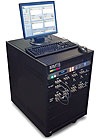
Ford
uses the MMTS Moving Video Test System to perform functional tests on the SYNC
system’s electronic components. Photo courtesy VI Technology.
In January 2007, Ford Motor Co. introduced its Ford SYNC technology at the annual North American International Auto Show. Developed jointly with Microsoft, Ford SYNC was initially offered on 12 2008 model year Ford, Lincoln and Mercury vehicles.
SYNC is a factory-installed, in-car communications and entertainment system that lets drivers bring nearly any mobile phone and some digital media players into their vehicle and operate them using voice commands, the vehicle’s steering wheel or radio controls. Utilizing the USB port, SYNC’s Windows-based operating system can be updated to work with new personal electronic devices. SYNC can even receive text messages and read them aloud using a digitized female voice.
The second generation of Ford SYNC was recently introduced and appears on 2010 model year vehicles. New features include traffic alerts, turn-by-turn directions and information services such as weather, sports, news and 411 business search. These services are being offered free for three years to the original owner of the vehicle.
Ford uses the MMTS Moving Video Test System from VI Technology to perform functional tests on the SYNC system’s electronic components. The automated MMTS tests consumer and military electronics, such as set-top boxes, smart phones, night-vision systems and automotive telematics. It automatically detects intermittent video and digital errors, including stop-and-go frames, pixelization, attenuation and noise.
VI Technology works closely with Ford’s design team to customize MMTS tests for the Bluetooth, Wi-Fi, USB, and audio and video features found in SYNC. A key feature of the MMTS is its scalable architecture, which enables engineers to easily create tests or add existing ones. These customized tests, and the ability of MMTS to test up to eight devices simultaneously, are essential to Ford’s aggressive 2010 production plans.
“Ford required fast and accurate automated measurements for a variety of multimedia technologies in a high-volume production environment,” says Alex Backus, vice president of strategic development at Aeroflex Corp., VI Technology’s parent company.
MMTS includes the hardware, software, algorithms, and extensions needed for testing all the components in a device. Based on the National Instruments PXI platform, MMTS can be used to test all the components in an electronic assembly, including analog and digital video and audio, power sources, USB, modem and Ethernet connectivity.
MMTS also eliminates the need for stand-alone measurement devices, providing engineers with two key benefits. The first is a reduced footprint on the production floor. Secondly, external timing and synchronization mechanisms are not needed between measurement devices.
For more information about video test systems, call 888-689-4415 or visit www.vi-tech.com/mmts.



